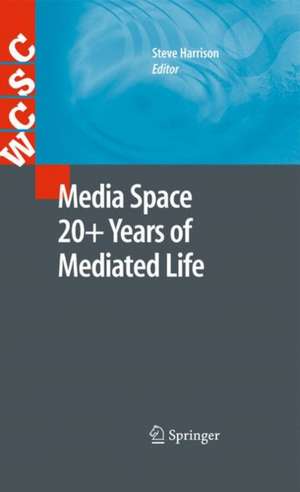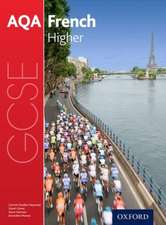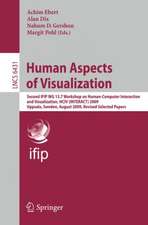Media Space 20+ Years of Mediated Life: Computer Supported Cooperative Work
Editat de Steve Harrisonen Limba Engleză Hardback – 12 iun 2009
| Toate formatele și edițiile | Preț | Express |
|---|---|---|
| Paperback (1) | 995.89 lei 43-57 zile | |
| SPRINGER LONDON – 21 oct 2010 | 995.89 lei 43-57 zile | |
| Hardback (1) | 1002.34 lei 43-57 zile | |
| SPRINGER LONDON – 12 iun 2009 | 1002.34 lei 43-57 zile |
Din seria Computer Supported Cooperative Work
- 20%
 Preț: 1044.25 lei
Preț: 1044.25 lei - 20%
 Preț: 650.59 lei
Preț: 650.59 lei - 20%
 Preț: 647.61 lei
Preț: 647.61 lei - 20%
 Preț: 638.55 lei
Preț: 638.55 lei - 20%
 Preț: 334.53 lei
Preț: 334.53 lei - 20%
 Preț: 328.79 lei
Preț: 328.79 lei - 20%
 Preț: 334.71 lei
Preț: 334.71 lei - 20%
 Preț: 330.90 lei
Preț: 330.90 lei - 20%
 Preț: 328.79 lei
Preț: 328.79 lei - 20%
 Preț: 649.28 lei
Preț: 649.28 lei - 20%
 Preț: 643.50 lei
Preț: 643.50 lei - 20%
 Preț: 329.91 lei
Preț: 329.91 lei - 15%
 Preț: 642.83 lei
Preț: 642.83 lei - 20%
 Preț: 648.11 lei
Preț: 648.11 lei - 20%
 Preț: 996.40 lei
Preț: 996.40 lei - 20%
 Preț: 647.79 lei
Preț: 647.79 lei - 20%
 Preț: 413.81 lei
Preț: 413.81 lei - 20%
 Preț: 336.02 lei
Preț: 336.02 lei - 20%
 Preț: 346.10 lei
Preț: 346.10 lei - 20%
 Preț: 330.24 lei
Preț: 330.24 lei - 20%
 Preț: 982.36 lei
Preț: 982.36 lei - 20%
 Preț: 329.11 lei
Preț: 329.11 lei - 20%
 Preț: 987.32 lei
Preț: 987.32 lei - 20%
 Preț: 641.34 lei
Preț: 641.34 lei - 20%
 Preț: 648.26 lei
Preț: 648.26 lei - 20%
 Preț: 995.89 lei
Preț: 995.89 lei - 20%
 Preț: 643.63 lei
Preț: 643.63 lei - 20%
 Preț: 988.98 lei
Preț: 988.98 lei - 20%
 Preț: 328.42 lei
Preț: 328.42 lei - 20%
 Preț: 988.81 lei
Preț: 988.81 lei - 20%
 Preț: 643.30 lei
Preț: 643.30 lei - 20%
 Preț: 987.17 lei
Preț: 987.17 lei - 20%
 Preț: 329.58 lei
Preț: 329.58 lei - 20%
 Preț: 309.58 lei
Preț: 309.58 lei - 20%
 Preț: 330.42 lei
Preț: 330.42 lei - 5%
 Preț: 365.82 lei
Preț: 365.82 lei - 20%
 Preț: 650.08 lei
Preț: 650.08 lei - 20%
 Preț: 334.38 lei
Preț: 334.38 lei - 20%
 Preț: 645.79 lei
Preț: 645.79 lei - 20%
 Preț: 650.40 lei
Preț: 650.40 lei - 20%
 Preț: 333.88 lei
Preț: 333.88 lei - 20%
 Preț: 1263.81 lei
Preț: 1263.81 lei - 20%
 Preț: 830.58 lei
Preț: 830.58 lei - 20%
 Preț: 704.70 lei
Preț: 704.70 lei
Preț: 1002.34 lei
Preț vechi: 1252.92 lei
-20% Nou
Puncte Express: 1504
Preț estimativ în valută:
191.86€ • 208.47$ • 161.27£
191.86€ • 208.47$ • 161.27£
Carte tipărită la comandă
Livrare economică 21 aprilie-05 mai
Preluare comenzi: 021 569.72.76
Specificații
ISBN-13: 9781848824829
ISBN-10: 1848824823
Pagini: 476
Ilustrații: VIII, 466 p.
Dimensiuni: 155 x 235 x 34 mm
Greutate: 0.84 kg
Ediția:2009
Editura: SPRINGER LONDON
Colecția Springer
Seria Computer Supported Cooperative Work
Locul publicării:London, United Kingdom
ISBN-10: 1848824823
Pagini: 476
Ilustrații: VIII, 466 p.
Dimensiuni: 155 x 235 x 34 mm
Greutate: 0.84 kg
Ediția:2009
Editura: SPRINGER LONDON
Colecția Springer
Seria Computer Supported Cooperative Work
Locul publicării:London, United Kingdom
Public țintă
ResearchCuprins
An Introduction to Media Space.- A Brief History of Media Space Research and Mediated Life.- Section 1: The Social Space.- Creating Assemblies in Media Space: Recent Developments in Enhancing Access to Workspaces.- From Media Spaces to Emplaced Media: Digital Poster Boards and Community Connectedness.- Social Catalysts for Creating Sociable Media Spaces.- Privacy Factors in Video-Based Media Spaces.- Affect and Dyads: Conflict Across Different Technological Media.- The Watcher and the Watched: Social Judgments about Privacy in a Public Place.- (Dis)connecting Cultures: The Diary of a Short Lived Media Space.- Section 2: The Space of Media Space.- Constructing Space.- Mediaspace – Meaningspace – Meetingspace.- Media Space, After 20 Years.- From Analog to Digital, from the Office to the Living Room: Why I Happily Worked in a Media Space but Don't Live in One.- The Video Window: My Life with a Ludic System.- Section 3: Communications.- Bringing Media Spaces Back to the Streets.- Media Spaces and Mobile Video Telephony.- Media Spaces, Emergency Response and Palpable Technologies.- Videoconferencing and Connected Rooms.- The Halo B2B Studio.- Presence in Video-Mediated Interactions: Case Studies at CSIRO.- Build It: Will They Come?.- Section 4: Where Are We?.- Fast Forward: Applying Media Space Experiences to Current Technologies.- Reflecting on Several Metaphors of MUD-Based Media Spaces.- Making Contact.
Textul de pe ultima copertă
From holes in space and telepresence to mobile technologies and online communities, media spaces crystallize socially-aware networked media-rich computing. This book provides perspectives on this fast-moving field.
Loosely divided into three different, but interconnected, approaches to media space research, each section implies a different exploration of the connectivity that constitutes a media space: social, spatial, and communications.
Each part opens with an introduction that lays out how readers can best approach the section, and provides a basic guide to the theory and research literature, technological developments and other notable events to help contextualize the book. The ‘social ‘ approach uses the rhetoric and methods familiar to a CSCW audience, but moves into actual situations that involve close working bonds, broken trust, shared joy, community building, interpersonal tension, anxiety and so forth. The section on ‘spatial’ approaches guides the reader through an intellectual landscape of spatiality, the ‘communications’ part is a field guide to sense-making in the as-lived mediated condition, demonstrating that media space sense-making combines an understanding of in-the-moment alongside sense made of existence in the world and reflecting upon it.
Students, researchers and practitioners of CSCW, information and communications technology (ICT), and human-computer interaction will find the book an invaluable reference to the past and an inspiration for the future. Also, historians of science and technology will be interested in the way media space history tracks the growth of CSCW and the expansion of HCI to include video and other communications technology.
Loosely divided into three different, but interconnected, approaches to media space research, each section implies a different exploration of the connectivity that constitutes a media space: social, spatial, and communications.
Each part opens with an introduction that lays out how readers can best approach the section, and provides a basic guide to the theory and research literature, technological developments and other notable events to help contextualize the book. The ‘social ‘ approach uses the rhetoric and methods familiar to a CSCW audience, but moves into actual situations that involve close working bonds, broken trust, shared joy, community building, interpersonal tension, anxiety and so forth. The section on ‘spatial’ approaches guides the reader through an intellectual landscape of spatiality, the ‘communications’ part is a field guide to sense-making in the as-lived mediated condition, demonstrating that media space sense-making combines an understanding of in-the-moment alongside sense made of existence in the world and reflecting upon it.
Students, researchers and practitioners of CSCW, information and communications technology (ICT), and human-computer interaction will find the book an invaluable reference to the past and an inspiration for the future. Also, historians of science and technology will be interested in the way media space history tracks the growth of CSCW and the expansion of HCI to include video and other communications technology.
Caracteristici
Provides an avenue not only into the progress of Media Spaces themselves, but also into what constitutes progress in CSW and technology development more generally

























